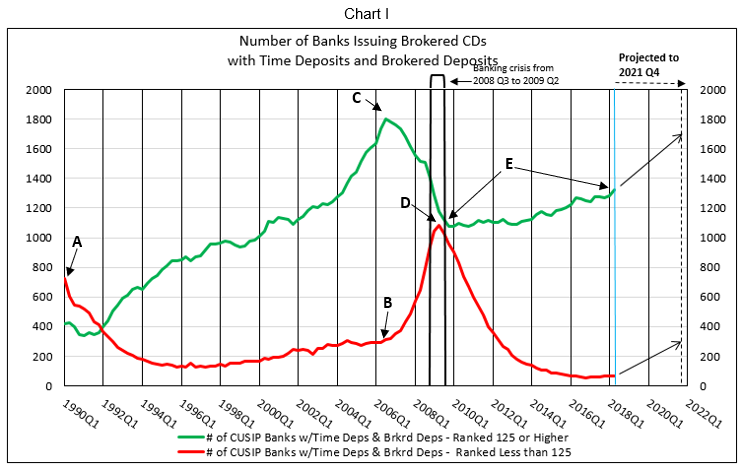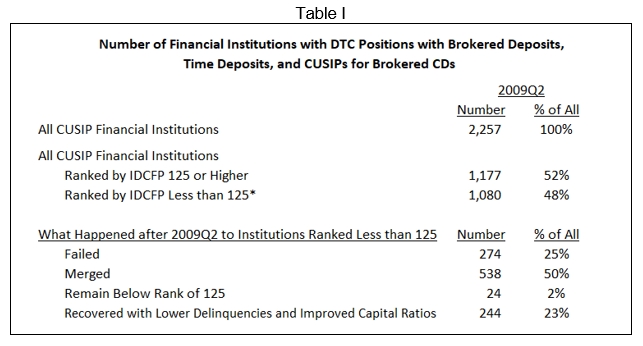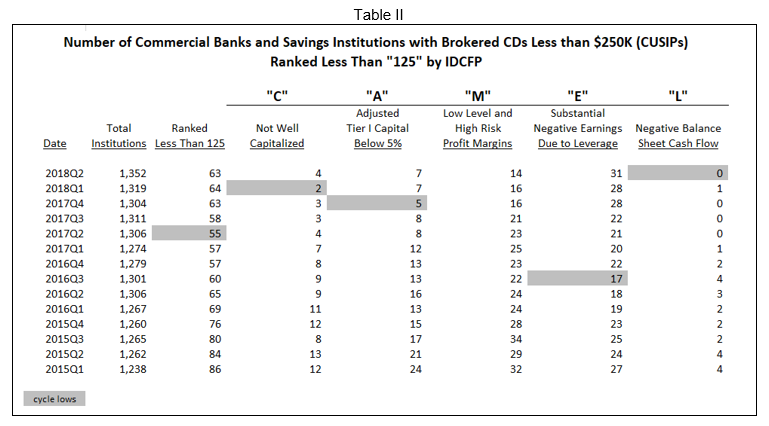IDC’s Remarkable Record Predicting Bank Failure and Recovery
Updated for 2nd Quarter 2018 ranks
Washington State Department of Financial Institutions has listed on their website “IDC has a remarkable track record of identifying deteriorating or improving performance months, and sometimes years, before it becomes apparent to other ranking companies.” From 1990 to 2018, there were 1,423 failures of banks. Of these, 89% (1,272 banks) were ranked less than 125 by IDCFP up to 17 months before failure. Further, 73%, (1,033 banks) were rated less than 125 by IDCFP up to 29 months before a collapse.
IDC Financial Publishing’s (IDCFP) CAMEL ratings of banks, savings institutions, and credit unions range from 300 (the top grade attainable) to 1 (the lowest). From the early 1990’s, through today, institutions using IDCFP’s CAMEL ranks determined that ratings lower than 125 were deemed below investment grade. This article discusses banks which issued brokered CDs, and how IDCFP’s ranking of these banks predicted institution failure, the banking crisis of 2008 to 2009, and post-crisis institution mergers. We also provide an outlook for the future.

In Chart I above, the red line plots the numbers of banks with an IDCFP rank less than 125. The number of these high-risk banks reached peak levels in the early 90’s (A), following the banking crisis in the late 80’s. The number of high-risk banks issuing brokered CDs then declined and stabilized at low levels until 2006.
IDCFP’s Ranks Forecast the Banking Crisis of 2008 - 2009
In early 2006, the number of banks with an IDCFP rank below 125 began to accelerate (B). At the end of that same year, banks with a rank of 125 or higher, peaked at 1800 (C) and began a decline. Together, the change in the numbers of these banks forecast the crisis of 2008-2009. The peak and decline in the red line (D) illustrate the end of the banking crisis, and the beginning of the resolution of high risk banks.
The second quarter of 2009 produced the largest number of institutions with an IDCFP rank below 125, reaching peak level (D). In 2009 Q2 all banks with brokered deposits, time deposits and CUSIP numbers for outstanding CDs numbered 2,257. Out of this total, 1,177 (52%) banks were ranked 125 or higher, and 1,080 (48%) were ranked by IDCFP less than 125.
Out of the 1,080 high-risk banks, 274 (25%) failed, 538 (50%) merged, 24 (2%) are currently below investment grade, and 244 (23%) recovered, attaining a rank of 125 or above due to reduced delinquencies or improved capital ratios as of the 2nd quarter of 2018.

The Number of Bank Failures Accelerated until June 2010

*Excludes three failures due to fraud
Select Bank Mergers Improve Financials
From June 2009 to June 2018, a total of 538 institutions merged that were ranked below 125 as of June 2009 (see Table I). Of these, 395 institutions that were ranked less than 125 merged into surviving institutions ranked 125 or higher. The low institution rank was published prior to the merger and was a measure of high risk. As a result, the 395 merged institutions not only survived, but also benefited, as the IDCFP rank on a bank, with CDs in existence, or to be issued, rose from below investment grade to above.
The Importance of IDCFP’s Ranks to Monitor Institutions Post-Banking Crisis
The demand for IDCFP ranks, measuring the safety and soundness of banks, continued strong from 2008 and post-crisis as banks continued to fail and merged with higher rated surviving institutions.
- As of June 30, 2009, banks and savings institutions ranked less than 125 totaled 1080, or 48% of all ranked institutions (see Table I).
- Despite the peak in the number of high risk banks in June 2009, failure of banks and savings institutions continued to accelerate into June 2010 and remained high through June 2013.
- Of the 538 mergers from June 2009 to June 2018, 395 of these were ranked less than 125, or below investment grade, at the time of the merger, thereby improving their rank with the merger.
- When the resolution of the Banking Crisis of 2008/2009 occurred, the number of banks ranked less than 125 declined significantly from June 2009 to June 2014 and was primarily due to bank failures and mergers mentioned above.
- Only 244, or 23% of institutions ranked below 125 survived failure or were not involved in a merger.
Crisis then Recovery
The total number of financial institutions issuing brokered CDs ranked over 125 in the 2nd quarter of 2009 was 1,177 and has grown to 1,289 as of June 30th, 2018. Not only did the number of investment grade institutions grow by 112 in over 8 years, but, in addition, the 812 institutions below investment grade as of June 2009 (274 failures and 538 mergers) were replaced by new banks.
The increase in the number of institutions ranked below 125 clearly predicted the banking crisis of 2008, as early as 2006 when those numbers began to rise. The peak and subsequent decline in lower-ranked institutions also correctly forecast the end of the banking crisis in 2009. Finally, the increase in new banks issuing brokered CDs, the replacement of 812 institutions, plus the sharp decline in number of high-risk banks, all illustrated the recovery period from 2010 to 2018 (E, Chart I). Use of IDCFP ranks of banks was critical for investors in brokered CDs during this recovery period.
IDCFP’s Outlook for the Future; Why Our Ranks are Critical for Investors
Like the period of increasing bank risk seen in 2005-2006, the year 2017 witnessed a low number of financial institutions ranked below 125, That low of 55 has subsequently increased to 63 in the 2nd quarter of 2018. Most components of IDCFP’s CAMEL analysis reached cycle lows during 2017-2018, while the remaining component “M” is still approaching a cycle low (see Table II). From 2018 Q2 to 2021, IDCFP projects the 63 banks, currently ranked below 125, will increase to 300 institutions. As the number of high-risk banks increases, so does risk to CD portfolios.

However, a strong economy, bank deregulation and favorable interest rates drive a healthy banking environment. Banks issuing brokered CDs are expected to increase dramatically over the next few years. In addition, with continued strength of the economy and strong loan demand for select financial institutions, IDCFP forecasts the number of banks ranked 125 or higher to accelerate from 1289 in 2018 Q2 to 1700 by 2021 (see Chart I). As in the past, IDCFP’s ranks are critical for investors going forward.
For further information or to view our products and services please feel free to visit our website at www.idcfp.com or contact us at 800-525-5457 or info@idcfp.com.
John E Rickmeier, CFA, President jer@idcfp.com
Robin Rickmeier, Marketing Director
